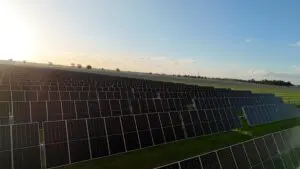Researchers at Aalborg University are working on a new approach at capturing a broader spectrum of sunlight using new, high-temperature materials that can withstand 800 degrees Celsius and convert sunlight into electricity.

A group of researchers based out of Aalborg University in Denmark have developed an early-stage, tungsten-based technique for broadening the spectrum at which sunlight can be converted into electricity.
Taking their cue from previous broadband solar absorption techniques based on metal-insulator-metal (MIM) resonators, the team from Aalborg switched out incumbent metals such as chromium or gold for tungsten, which has a higher resistance to heat. Metals in standard MIM resonators typically melt at around 500 degrees Celsius, and are made more susceptible to melting the thinner their layers, rendering them incompatible for solar cell use in thermophotovoltaic (TPV) applications.
In searching for an alternative, durable and inexpensive method for capturing a broad spectrum of sunlight using materials resistant to such temperatures, the Danish researchers discovered that alumina sandwiched as an insulator between two layers of tungsten worked well as MIM resonators, able to not only operate at temperatures approach 800 degrees Celsius, but also able to capture sunlight from 300 to 1,750 nanometers – a spectrum ranging from UV to infrared light.
By absorbing a wider spectrum of sunlight, such solar cells deliver higher efficiencies. By using this technique, the researchers hope to one day develop cells more affordably than multi-junction cells, which are the current go-to product for absorbing wide wavelengths of sunlight.
Such multi-junction cells are still relatively expensive to produce, whereas a tungsten-alumina MIM resonator could theoretically be much cheaper, more effective and – unlike current MIM resonators – more resistant to heat and thermal shock, which is critical for solar cell use and production.
“MIM resonators absorbing in the spectral region from UV to near-infrared can be directly employed in different applications, such as solar TPV and solar thermal systems,” said Aalborg University’s Manohar Chirumamilla, who authored a paper about the technique for the journal, Optical Materials Express. The resonators could also be used in CSP applications, the researcher added.
“This is the first step in utilizing the energy of the sun in a more efficient way than with current solar cells,” he said. “Using an emitter in contact with our absorber, the generated heat can then be used to illuminate a solar cell—which can then function more efficiently when it is placed directly in the sun.”
Source: PV Magazine. Reproduced with permission.








